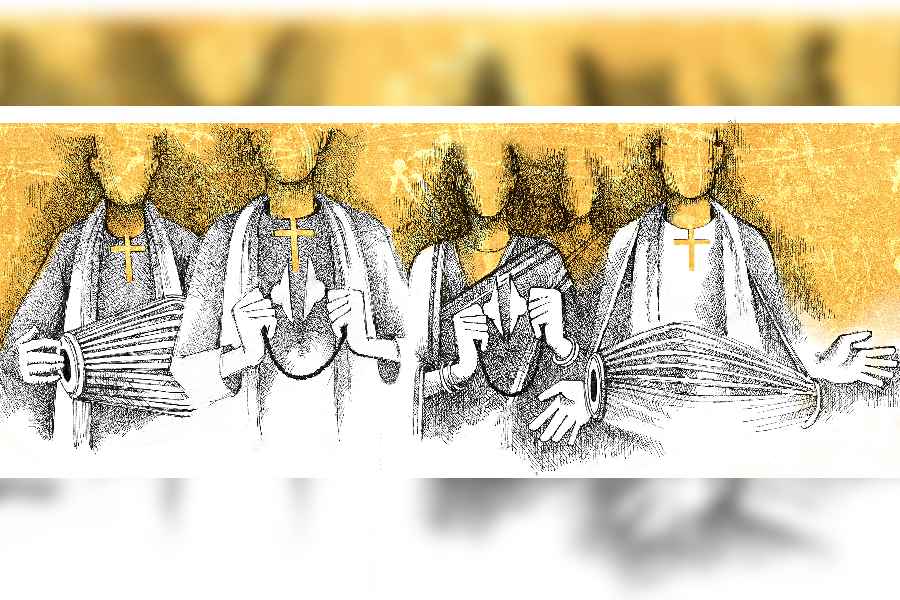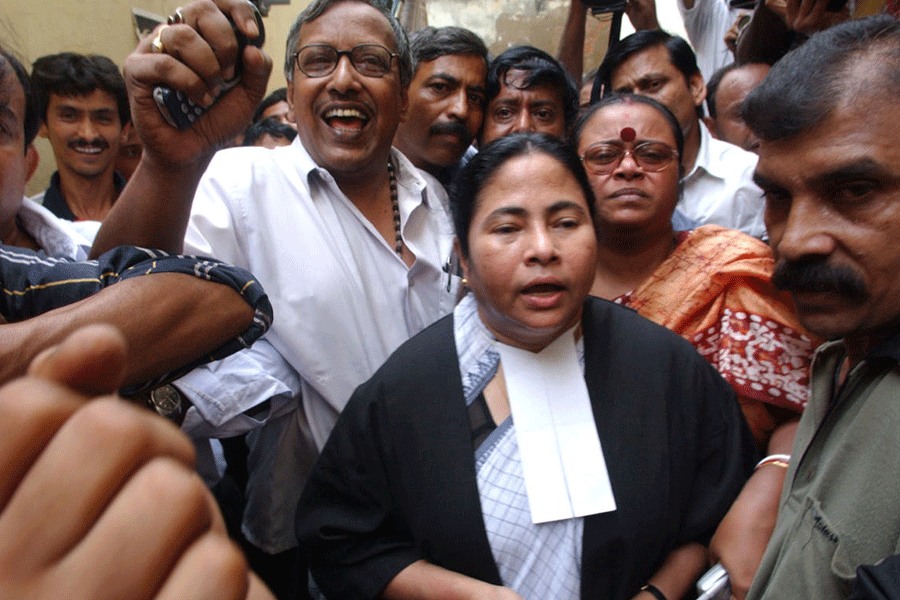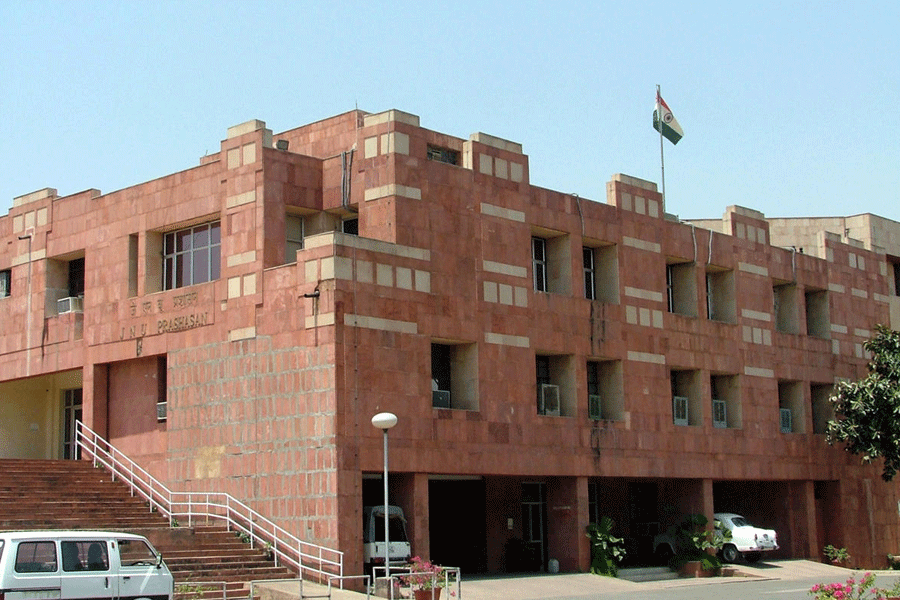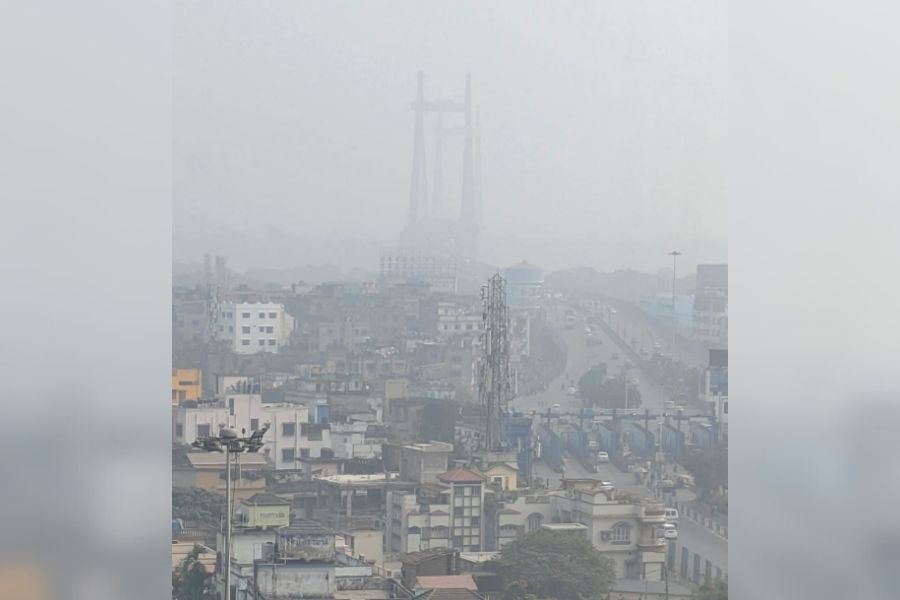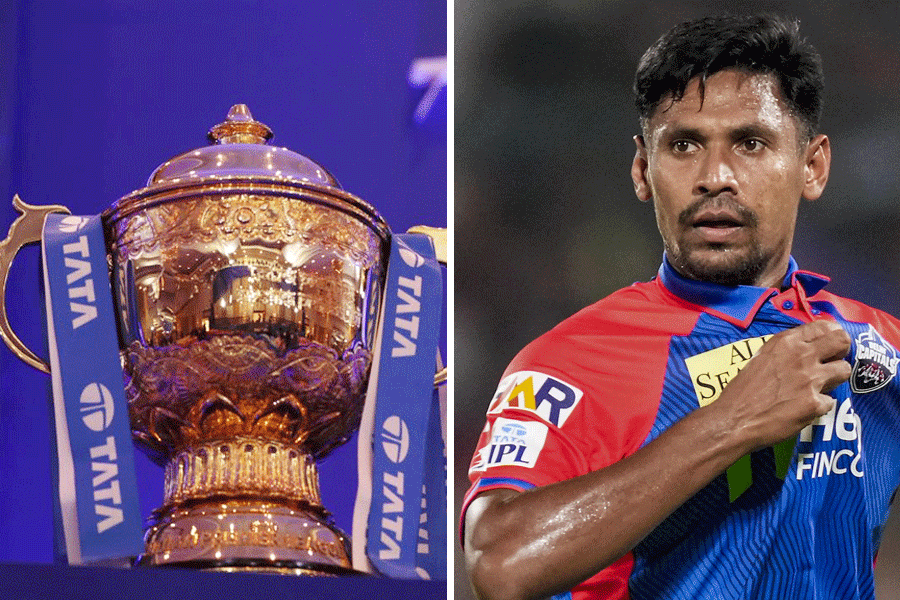Rajarampur village is close to Calcutta and also much removed from it. It is not too far from Thakurpukur but located in South 24-Parganas, a place of still-materialising roads, pukurs or ponds on either side and not enough autorickshaws. It takes the 82-year-old kirtaniya Sudhakar Mondol half an hour to cycle down from Rajarampur to Kabardanga in south Calcutta, but a century and more has not been time enough for Krishtokirtan to arrive some place close to Park Street any which way.
Kirtan is a genre of performative devotional music. Its earliest examples in Bengal are associated with the Gaudiya Vaishnava communities, songs in praise of Krishna dating back to the 16th century. Krishtokirtans were conceived at least 200 years ago. Their subject is not Krishna but Krishto, meaning Christ.
This genre was most likely thought up by enthusiastic Christian missionaries. Rajarampur is considered the cradle of Krishtokirtan. But more about that later.
I am to meet Mondol in Pradeep Dolui’s house in Kabardanga. In Calcutta, the largest concentration of Christians is most likely in this area, stretching all the way down to Nepalganj, which is also in South 24-Parganas, and beyond.
Kabardanga takes its name from the three burial grounds in the area. Kabar means cemetery. One knows of the cemeteries in Park Street, Mullickbazar and Bhowanipore; Kabardanga’s cemeteries also go back to the late 19th century but they are not as well known. Resting in these grounds is a set of people from a different social orbit.
“The original name of Kabardanga is Ramchandrapur but no one remembers that anymore,” says Dolui, who is Mondol’s relation and a Kabardanga resident for the last three decades. He is hosting us at the behest of his neighbour and academic Suranjan Midde, who has written a book in Bengali titled SriKrishtokirtan.
The idea is Mondol will sing a couple of songs, Midde will provide the footnotes and Dolui will keep plying us with tea. Mondol and Midde do their bit as expected, and Dolui turns out to be the surprise, wisely sutradhar.
I have never heard Krishtokirtan, never met a Krishtokirtaniya. How are they different from church choirs?
Dolui replies, “Choirs come under the church. Krishtokirtans are not directly connected with the church.” Mondol adds, “Besides, choirs can experiment with the tune, the tempo; but kirtans have to adhere to a template.”
Will Mondol oblige us by singing a line or two? Just so I get an idea.
The elder is hesitant — he suffered a cerebral stroke not long ago and his memory is not what it used to be. His intermittent refrain is, “Just read the book.”
He means Midde’s work wherein he has painstakingly chronicled the tradition of Krishtokirtan, made a list of kirtaniyas, collated their backstories and of course, several of the kirtans. Mondol’s friends scold, egg him on. At first, he only recites a line, but the company is relentless. “Sing, sing, don’t recite, shoore korun...” Midde urges.
Mondol starts to protest, “It’s all there in the book... Have you forgotten about my stroke...” and then, just like that in the middle of a protracted apo-
logy for his impaired memory, he bursts into song — “Bhai re, shojolo noyone…” His plaintive voice plucks
at the smoggy winter morning, making it quiver with love and devotion and piety. “Boli ki jatona bhugechhinu…” He continues singing about Jesus and
the crucifixion.
Krishtokirtans are the result of Carey’s influence, says Midde. William Carey, who was the founder of the
English Baptist Missionary Society, arrived in Bengal in 1793. He transla-
ted the Bible into Bengali, Odia, Marathi, Hindi, Assamese, Sanskrit and more than two dozen dialects. Midde also talks about the arrival and subsequent work of the London Missionary Society (LMS) in these parts; how its missionaries moved around riverine south Bengal in shaltis or small boats, stopping at every village.
What made the missionaries hone in on the kirtan to spread the word about and of Christ? Midde’s reply, “What words cannot do, songs can achieve.”
The LMS was an interdenominational missionary society but in rural Bengal Protestant missionaries were at work. Unlike the missionaries in Calcutta who experimented with English language education, their counterparts in the villages focussed on Bengali. In her book Pedagogy for Religion: Missionary education and the fashioning of Hindus and Muslims in Bengal, Parna Sengupta draws attention to several practices of missionaries of which one seems to lend some kind of answer to the question of why Vaishnav padabali.
Sengupta writes about the lower- caste, literate, purdah-free and wandering bairagi women of mid-19th century southeastern Bengal being identified by school inspector Mr Martin as the logical female cognate or counterpart of the gurumahashoy or indigenous male teacher. Is it possible that the missionaries also sought the help of these bairagis to aid their cause?
Dolui, who is originally from Shalpukur in South 24-Parganas, recalls his father attending Harinam as well as Krishtokirtan. In an email from the US, Sengupta, who is director and associate vice-provost of Stanford Introductory Studies, writes, “I had not read in the work on Carey anything specifically concerning this, but it does not make it any less possible (and in some ways it is more important that this is how the origins of this tradition is remembered).” She nudges me towards a “historic parallel”, the Jarigan, which expresses the stories of Muharram. According to Mary Dunham, who has done extensive research on the subject, one of the models of Jarigan may have been “song-poems of the Vaishnava poets who sang in praise of Chaitanya”.
In Rajarampur, Krishtokirtaniyas are dime a dozen. “You will find kirtaniyas going back five to six generations,” says Midde. Mondol’s guru was Haran Chandra Makhal, whose guru was Subol Mondol. Mondol’s father was a kirtaniya and so was his elder brother.
All these men held day jobs. Mondol worked as a clerk with a private company in central Calcutta for the greater part of his life. His father was a carpenter. “Like Jesus,” says Midde and everyone laughs out loud.
Between Mondol, Midde and Dolui, they incantate names — Manohar Mondol, Father Pankaj Pati, Paul Naiya, Shanti Bor, Father Abani Sardar. I get a sense of pride in the shared legacy, the familiarity, the popularity of the genre. Rajarampur seems near but also far, another orbit of life, rather another stellar system. The trio starts to list the subgenres of Krishtokirtan. Dak naam or dak kirtan which is about singing Christ’s praise. Padabali kirtan wherein singing alternates with vyakhya or explanation. Both types feature in weddings, funerals and special occasions throughout the year.
“Forty days after a person’s death, the family hosts a memorial wherein kirtaniyas perform,” says Midde. Then there is nagar kirtan wherein a larger group of singers and musicians set out singing songs about Christ’s birth and death on Christmas Day and Easter. In Mondol’s heyday, there were nagar kirtans on Christmas eve in Thakurpukur.
The kirtan is sung to the accompaniment of a harmonium, khol or a double-headed barrel drum, kortal or cymbals, and violin. At this point Dolui interjects gently: “When I was a boy living in Shalpukur, not too many Christians knew how to play the khol; the Hindus did, they played the instrument.” The point is much appreciated by the other two men. Mondol starts to talk about kirtaniya Manohorda’s shishya, Kochikaka, who was a Hindu.”
Midde says, “In my village in Basanti, a boy called Ujjir Ali played the flute whenever the kirtaniyas performed. His mother disapproved.” Dolui adds, “It was not about different faiths or narrow -isms, it was about the shared culture of a place.”
In Mondol’s day and before, the kirtaniyas sang for the joy of it and to spread the gospels. The invitations came from Gosaba, Basanti, Pakhiralay, Ranigar, Jhorkhali, Canning, Howrah, Midnapore, Bongaon. “Basically riverine areas,” says Midde. “Each session would last at least 12 hours. Begin in the evenings and continue through the night,” he adds. They learnt from their fathers, brothers, village elders. Some of them, like Mondol, composed their own kirtans. Krishtokirtans are common to Protestants and Catholics and the groups too are mixed.
In his book, Midde has put out a list of all the kirtaniyas — more than 60 names. The oldest living kirtaniya is
90 years old and the youngest is 15. Each of them has been identified by name, guru, mission, location and pala. He has also spoken to 50 khol badaks, listed them as well by name, guru, church, location.
Will this cultural practice survive the onslaught of smartphones and streaming platforms? It might transform, but it will endure, says Midde. He is aware that sessions are becoming shorter, but young people from the Christian community are now taking formal training in Krishtokirtan, these days they charge a fee for every performance, also now there are many women’s kirtan groups — Mondol’s own niece has trained to be a kirtaniya...
And it’s time to wrap up this discussion. Mondol is getting restless. A young man from the community has got himself a good job, one in a college library, there is to be a prayer meet and kirtan that very evening. He needs to cycle back to Rajarampur.
Rajarampur, which is near and still
a world away.

